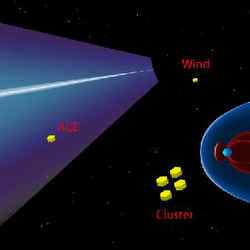
A graphic representing NASA’s ACE and Wind and ESA’s Cluster spacecraft encountering solar particle jets. Image credit: UC Berkeley Click to enlarge
A fleet of NASA and European Space Agency space-weather probes observed an immense jet of electrically charged particles in the solar wind between the Sun and Earth. The jet, at least 200 times as wide as the Earth, was powered by clashing magnetic fields in a process called “magnetic reconnection”.
magnetic reconnection in the solar wind
These jets are the result of natural particle accelerators dwarfing anything built on Earth. Scientists build miles-long particle accelerators on Earth to smash atoms together in an effort to understand the fundamental laws of physics.
Similar reconnection-powered jets occur in Earth’s magnetic shield, producing effects that can disable orbiting spacecraft and cause severe magnetic storms on our planet, sometimes disrupting power stations.
The newly discovered interplanetary jets are far larger than those occurring within Earth’s magnetic shield. The new observation is the first direct measurement indicating magnetic reconnection can happen on immense scales.
Understanding magnetic reconnection is fundamental to comprehending explosive phenomena throughout the Universe, such as solar flares (billion-megaton explosions in the Sun’s atmosphere), gamma-ray bursts (intense bursts of radiation from exotic stars), and laboratory nuclear fusion. Just as a rubber band can suddenly snap when twisted too far, magnetic reconnection is a natural process by which the energy in a stressed magnetic field is suddenly released when it changes shape, accelerating particles (ions and electrons).
“Only with coordinated measurements by Sun-Earth connection spacecraft like ACE, Wind, and Cluster can we explore the space environment with unprecedented detail and in three dimensions,” says Dr. Tai Phan, lead author of the results, from the University of California, Berkeley. “The near-Earth space environment is the only natural laboratory where we can make direct measurements of the physics of explosive magnetic phenomena occurring throughout the Universe.” Phan’s article appears as the cover article in Nature on January 12.
The solar wind is a dilute stream of electrically charged (ionized) gas that blows continually from the Sun. Because the solar wind is electrically charged, it carries solar magnetic fields with it. The solar wind arising from different places on the Sun carries magnetic fields pointing in different directions. Magnetic reconnection in the solar wind takes place when “sheets” of oppositely directed magnetic fields get pressed together. In doing so, the sheets connect to form an X-shaped cross-section that is then annihilated, or broken, to form a new magnetic line geometry. The creation of a different magnetic geometry produces extensive jets of particles streaming away from the reconnection site.
Until recently, magnetic reconnection was mostly reported in Earth’s “magnetosphere”, the natural magnetic shield surrounding Earth. It is composed of magnetic field lines generated by our planet, and defends us from the continuous flow of charged particles that make up the solar wind by deflecting them. However, when the interplanetary magnetic field lines carried by the solar wind happen to be in the opposite orientation to the Earth?s magnetic field lines, reconnection is triggered and solar material can break through Earth’s shield.
Some previous reconnection events measured in Earth?s magnetosphere suggested that the phenomenon was intrinsically random and patchy in nature, extending not more than a few tens of thousands of kilometers (miles). However, “This discovery settles a long-standing debate concerning whether reconnection is intrinsically patchy, or whether instead it can operate across vast regions in space,” said Dr. Jack Gosling of the University of Colorado, a co-author on the paper and a pioneer in research on reconnection in space.
The broader picture of magnetic reconnection emerged when six spacecraft ? the four European Space Agency Cluster spacecraft and NASA’s Advanced Composition Explorer (ACE) and Wind probes ? were flying in the solar wind outside Earth?s magnetosphere on 2 February 2002 and made a chance discovery. During a time span of about two and a half hours, all spacecraft observed in sequence a single huge stream of jetting particles, at least 2.5 million kilometers wide (about 1.5 million miles or nearly 200 Earth diameters), caused by the largest reconnection event ever measured directly.
“If the observed reconnection were patchy, one or more spacecraft most likely would have not encountered an accelerated flow of particles,” said Phan. “Furthermore, patchy and random reconnection events would have resulted in different spacecraft detecting jets directed in different directions, which was not the case.”
Since the spacecraft detected the jet for more than two hours, the reconnection must have been almost steady over at least that timespan. Another 27 large-scale reconnection events ? with the associated jets – were identified by ACE and Wind, four of which extended more than 50 Earth diameters, or 650,000 kilometers (about 400,000 miles). Thanks to these additional data, the team could conclude that reconnection in the solar wind is to be looked at as an extended and steady phenomenon.
The 2 February 2002 event could have been considerably larger, but the spacecraft were separated by no more than 200 Earth diameters, so its true extent is unknown. Two new NASA missions will help gauge the actual size of these events and examine them in more detail. The Solar Terrestrial Relations Observatory (STEREO) mission, scheduled for launch in May or June of 2006, will consist of two spacecraft orbiting the Sun on opposite sides of the Earth, separated by as much as 186 million miles (almost 300 million kilometers). Their primary mission is to observe Coronal Mass Ejections, billion-ton eruptions of electrically charged gas from the Sun, in three dimensions. However, the spacecraft will also be able to detect magnetic reconnection events occurring in the solar wind with instruments that measure magnetic fields and charged particles. The Magnetospheric Multi-Scale mission (MMS), planned for launch in 2013, will use four identical spacecraft in various Earth orbits to perform detailed studies of the cause of magnetic reconnection in the Earth’s magnetosphere.
Original Source: NASA News Release
